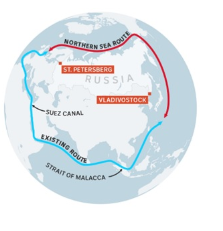12 Nov 2024 13:26:24 pm
International Relations
Northern Sea Route
Tags :
Northern Sea Route

Topic: Transportation
Why in the news?
- The India-Russia working group on cooperation in the Northern Sea Route (NSR) held their first meeting and discussed targets for IndianRussian cargo transit, possible training of Indian sailors for polar navigation and development of joint projects in Arctic shipbuilding.
Source: The Hindu
About Northern Sea Route:
- It is the shortest shipping route for freight transportation between Europe and Asia-Pacific countries.
- It spans four seas of the Arctic Ocean, starting at the boundary between the Barents and the Kara seas (Kara Strait) and ending in the Bering Strait (Provideniya Bay).
- The route measures 5,600 km in length.
- It remains icebound for most of the year, requiring icebreaking assistance for safe navigation.
Driving factors for India to participate in the NSR development:
- Cargo Traffic Growth: Cargo traffic along the NSR experienced a surge of around 73% from 2018-2022, with a volume of 34.117 million tonnes in 2022.
- Energy Imports: India’s increasing imports of crude oil and coal from Russia are facilitated by the NSR’s reliability and safety.
- Geographical Benefits: India’s major trade depends on sea transportation. The NSR offers a more efficient route, enhancing India’s trade potential.
- Chennai-Vladivostok Maritime Corridor (CVMC): It could link with the NSR, shortening transport time. The CVMC is 10,500 km, a significant reduction from the 16,000 km St. Petersburg-Mumbai route.
- Strategic Considerations: With potential collective influence from China and Russia over the NSR, India’s involvement can ensure balanced regional dynamics.

